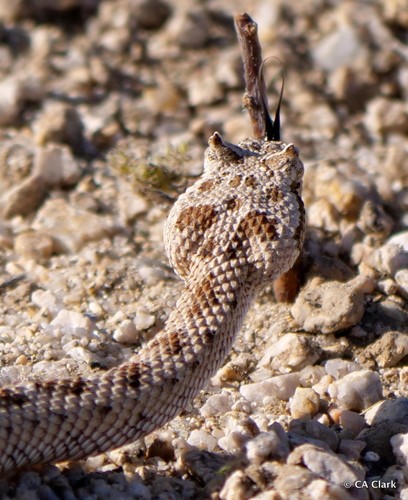Horned rattlesnake
A species of Rattlesnakes, Also known as Sidewinder rattlesnake, Sidewinder rattler Scientific name : Crotalus cerastes Genus : Rattlesnakes
Horned rattlesnake, A species of Rattlesnakes
Also known as:
Sidewinder rattlesnake, Sidewinder rattler
Scientific name: Crotalus cerastes
Genus: Rattlesnakes
Content
Description General Info
 Photo By sea-kangaroo , used under CC-BY-NC-ND 4.0 /Cropped and compressed from original
Photo By sea-kangaroo , used under CC-BY-NC-ND 4.0 /Cropped and compressed from original Description
The sidewinder (Crotalus cerastes), also known as the horned rattlesnake and sidewinder rattlesnake, is a venomous pit viper species belonging to the genus Crotalus (rattlesnakes) and is found in the desert regions of the southwestern United States and northwestern Mexico. Three subspecies are currently recognized, including the nominate subspecies described here.
General Info
Lifespan
10-20 years
Diet
Horned rattlesnake primarily feeds on small vertebrates, predominantly rodents. It dispatches prey with its venomous bite, then swallows it whole, benefiting from nutritional inputs like proteins and fats.
Appearance
Horned rattlesnake is a medium-sized snake with a thick, robust body covered in keeled, rough scales. Primarily sandy or tan in color, it mirrors the desert habitat it lives in, featuring dark crossbands varying in size. This snake's most unique feature is a pair of horns atop its eyes, attributed to enlarged supraocular scales. Males and females are similar, but males are generally larger and have more prominent 'horns'.
Behavior
Horned rattlesnake exhibits an unusual 'sidewinding' locomotion to navigate its sandy habitat effectively, a behavior unique among rattlesnakes. This nocturnal creature is solitary except during the mating season, hunting for small rodents by using its heat-sensing pits. Taking a non-aggressive stance, horned rattlesnake prefers to hide or escape from threats rather than engaging in conflict.
Population
Stable
Scientific Classification
Phylum
Chordates Class
Reptiles Order
Lizards and snakes Family
Vipers Genus
Rattlesnakes Species
Horned rattlesnake